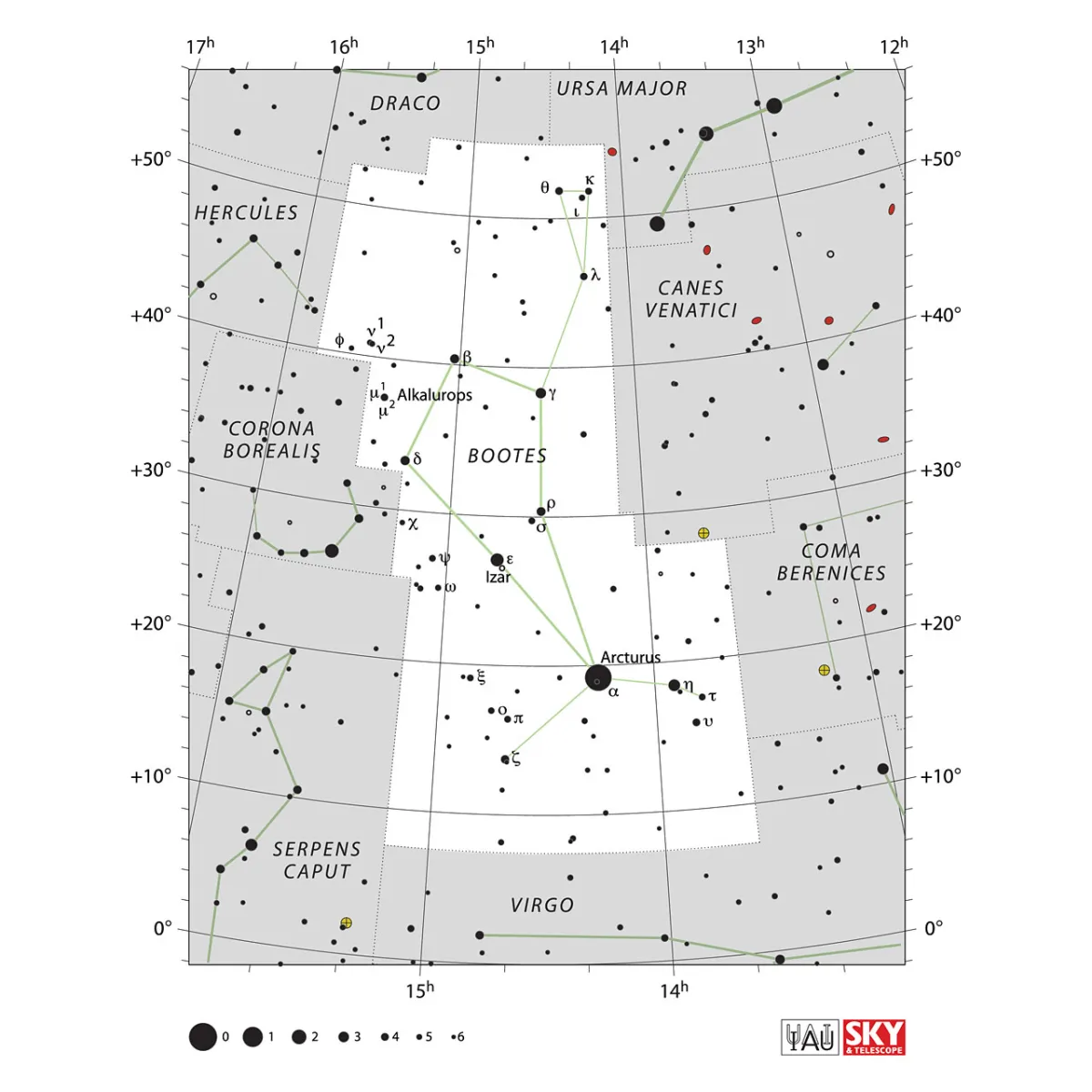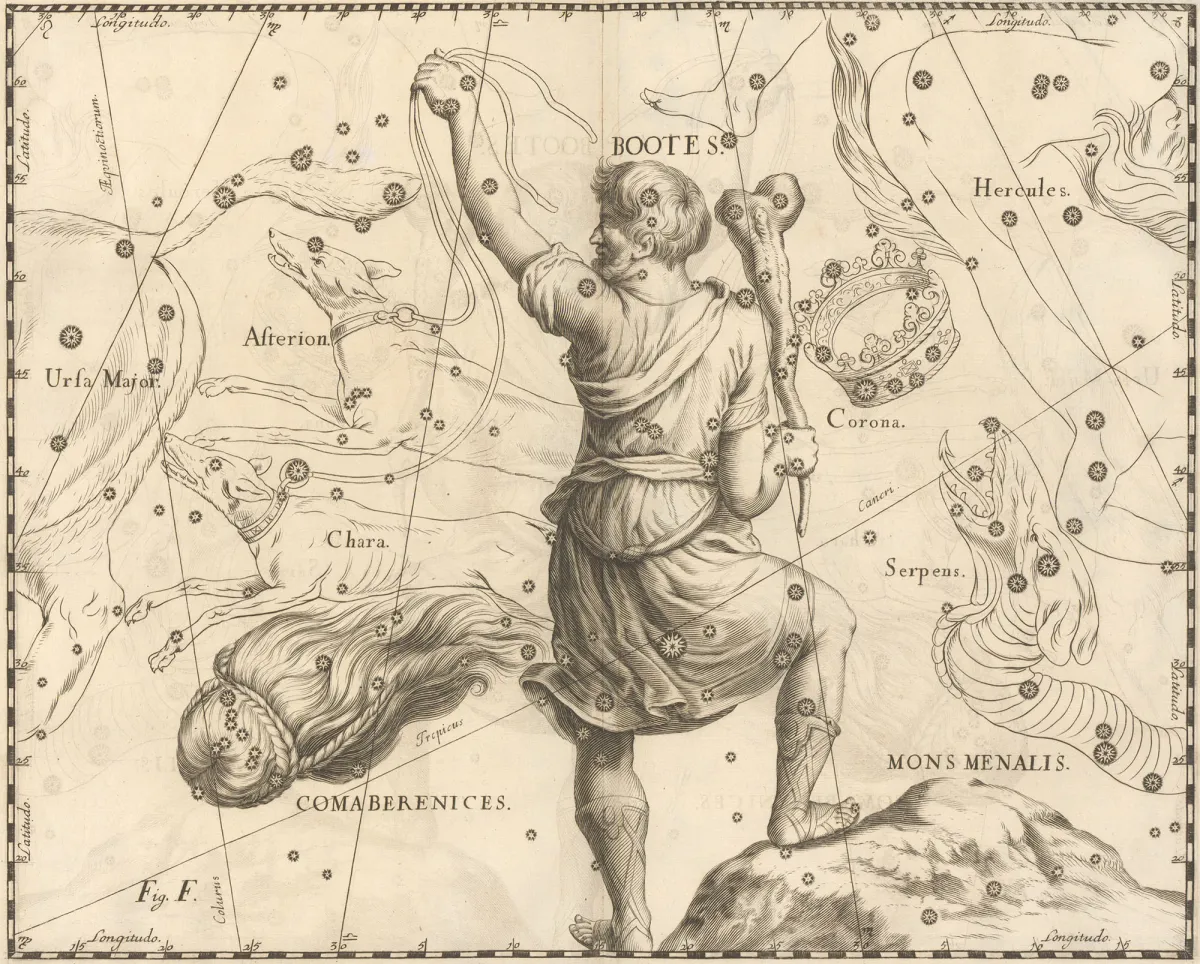Constellation Bootes (Herdsman)

Properties
The constellation Bootes is a typical spring constellation and is relatively easy to find, although at first glance it is not particularly noticeable in the sky. It is far from the band of the Milky Way, southeast of Ursa Maior. Follow the curve of the drawbar of the Big Dipper to Arcturus and on to Spica (alpha Virginis). The shape of the constellation Bootes is very memorable. Some see a paper kite in it, others an upside-down tie or a cornet (an ice cream cone). To the east of Bootes is the striking constellation Corona Borealis. Bootes has an area of 907 square degrees and the constellation centre culminates around midnight on April 30th. [9, 15]
| α Boo | Arcturus, Haris-El-Sema |
| β Boo | Nekkar, Merez, Meres |
| γ Boo | Seginus, Ceginus |
| ε Boo | Izar, Mirac, Mirak, Mirach, Mizar, Pulcherrima |
| η Boo | Mufrid, Muphrid, Mufride, Muphride |
| θ Boo | Asellus Primus |
| ι Boo | Asellus Secondus |
| κ2 Boo | Asellus Tertius |
| μ1 Boo | Alkalurops, Inkalunis, Icalurus, Clava, Venabulum |
| 38 Boo | Merga, Marrha, El Mara El Musalsela, Falx Italica |
| IAU Name | Bootes |
| IAU Genitive | Boötis |
| IAU Abbr. | Boo |
| English Name | Herdsman |
| Culmination at local midnight | 3 May |
| Season (Latitude +0.0°) | January … October |
| Right Ascension (J2000.0) | 13h 35m 49s … 15h 49m 28s |
| Declination (J2000.0) | +07° 21' 38" … +55° 02' 42" |
| Area | 907 deg2 |
| Neighbours (N↻) | Dra, UMa, CVn, Com, Vir, Ser, CrB, Her |
Deep-Sky Object Descriptions
Catalogues
Mythology and History
Bootes is a very old constellation and there are many stories to be told about it, some of which are even contradictory.
The name appeared over 3000 years ago. He is the shepherd or bear keeper and destined to herd in the vicinity of the great bear. Another interpretation sees it as the ox driver, because the Big Dipper in Ursa Maior was seen as an ox cart. The Egyptians considered Ursa Maior malicious and Bootes was supposed to guard him. The Egyptian name for bear guardian is hippopotamus. [58] In addition, in many of the depictions he is holding the leash of the hunting dogs.

In Greek mythology, Bootes is Ikarios. He learned from Dionysus, the god of fertility, wine and intoxication, the art of wine growing and pressing. Ikarios offered a sample of his art to a group of shepherds who, uncontrollably, drank the wine undiluted in large quantities until they thought they were enchanted because they saw some things twice. In their intoxication, they killed Ikarios because they thought he had poisoned them. After they had slept off their intoxication, they buried him under a fir tree and carefully covered all traces so that their deed would not be known. Ikarios' daughter Erigone did not know where her father was until her dog Maria dragged her by a corner of her robe to the place where her father had been buried by the murderers. Erigone was desperate and hanged herself from the Christmas tree that stood by her father's grave. The dog, troubled by their deaths, threw himself into a nearby well.
When Dionysus heard this terrible news, he was so furious that he cast a curse on the maidens in Athens, which caused them to hang themselves from trees. The citizens of Athens were so terrified that they consulted an oracle. The oracle said that the death of the virgins could only be stopped if Ikarios' murderers were found and punished. It was done quickly. Later the Athenians celebrated the death of Icarius and Erigone every year at the grape harvest festival. Drink offerings are made to Ikarios and Erigone and girls rock on ropes in the branches of trees, standing on small boards.
Dionysus gave Ikarios, his daughter and her dog a place under the stars. Ikarios became Bootes, Erigone became Virgo, and the dog became Canis Minor. [20, 58]

According to a story by Eratosthenes, however, the constellation represents Arkas, who is the son of Zeus, the father of the gods, and Callisto, the daughter of King Lykaon of Arcadia. One day Zeus was invited to dinner in the palace of the Lykaon. In order to check whether the guest really was the mighty Zeus, the king of the gods, Lykaon cut up his grandson Arkas and served him as a meal for Zeus. However, Zeus immediately recognized the flesh of his poor son and, in a furious rage, knocked over the table, killed Lycaon's sons with a lightning bolt, and turned Lykaon himself into a wolf. Then Zeus put the parts of his son back together and handed him over to the Pleiade Maia, who raised him.
In the meantime Callisto had been transformed into a bear by Zeus' jealous wife, Hera. When Arkas had grown up into a youth, one day he met the she-bear while hunting. Callisto recognized her son, but could only greet him with a grunt. Arkas did not understand this hum as maternal affection and then chased the she-bear, who fled to the temple of Zeus. This was a forbidden place and entering it was punishable by death. Zeus seized both of them and placed them in the sky as constellations.
According to one interpretation, the designation Bootes means the driver or coachman of a harvest wagon or Plaustri Cutos (guardian of the wagon). Others associate this name with the leader of the two dogs Chara and Asterion, which we now call hunting dogs and which we see in the immediate vicinity of the boat. The two are chasing the Big Bear around the pole and the boat rushes after them. Apparently Bootes makes a loud shouting to cheer the dogs on, because the designation Vociferator, Vociferans, Clamans, Clamator and Plorans means someone who raises his voice loudly, calls and screams. But he has also been called shepherd and bear guard. Cicero (106-43 BC) reports that he was also called Arctophylax (Arctophylax, vulgo qui dicitur esse Bootes). But it has also been called Arcturus, Portitor Ursae, Custos Arcti, Custor Erymanthidos Ursae and Arcturi Custos; all these names mean a guardian of the bear. Venator Ursae, the bear hunter, has been another common name. [20, 60]